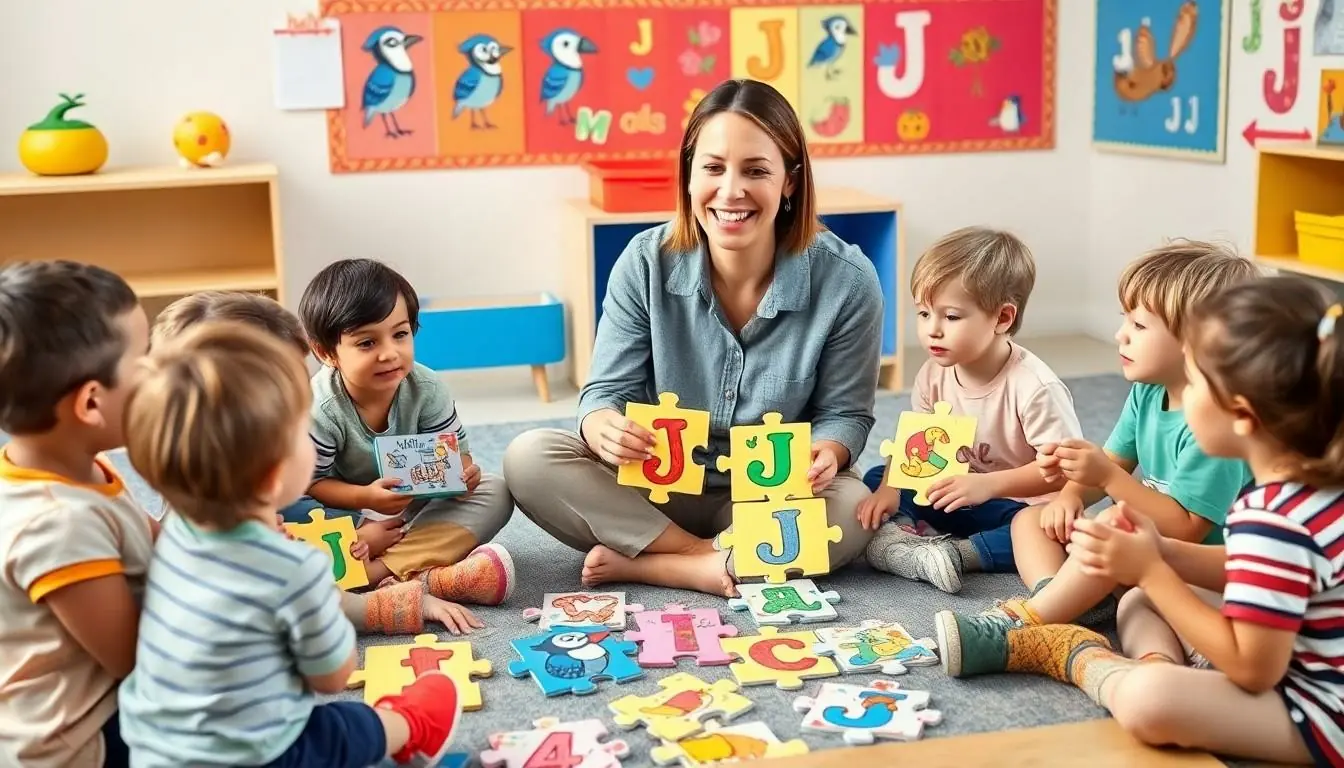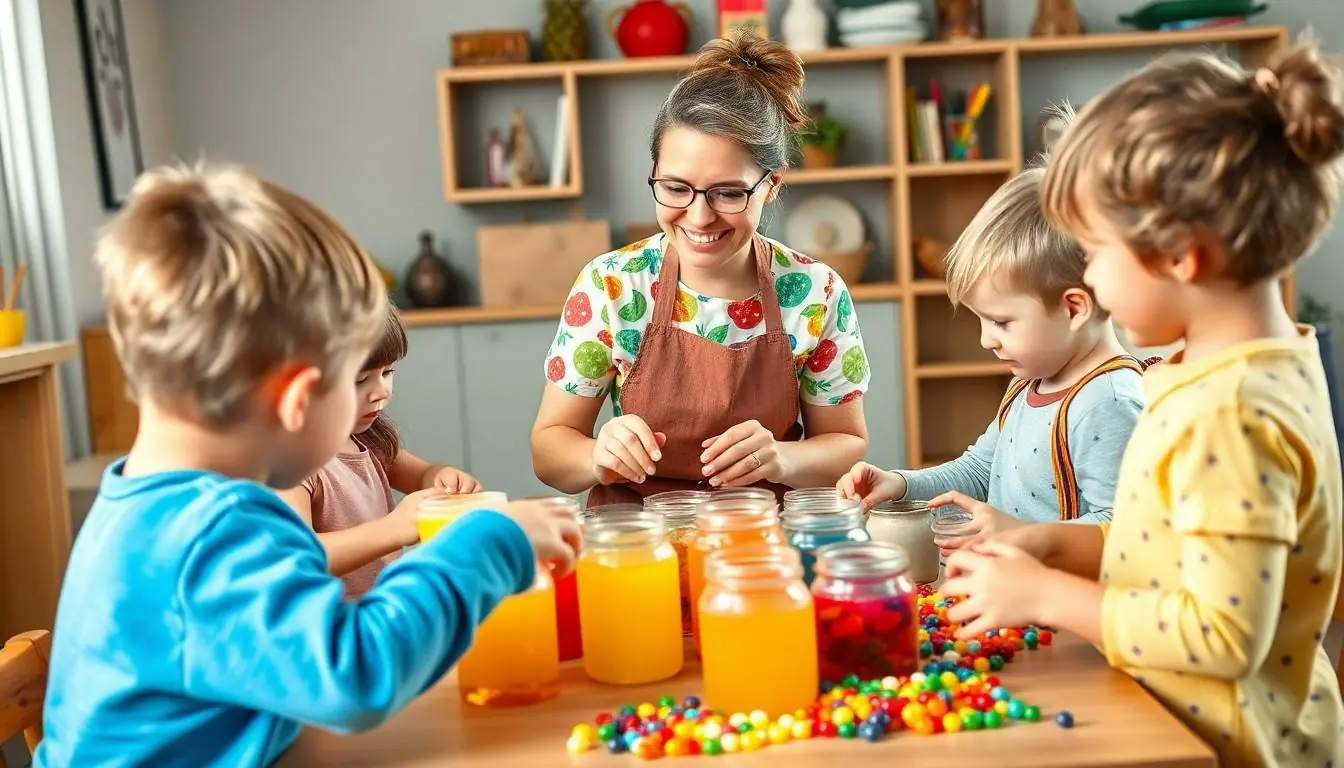Learning the letter J opens up a jumbo-sized world of fun and discovery for preschoolers. From jumping jacks to juicy jellybeans, this jazzy letter brings excitement to early education through playful words and engaging activities.
Teaching preschoolers about the letter J doesn’t have to feel like a juggling act. Parents and teachers can transform simple everyday objects and activities into memorable learning experiences that help little ones master this essential letter. With creative approaches and interactive methods, kids will be joyfully joining the J-word journey in no time.
Table of Contents
ToggleFun ‘J’ Words for Preschoolers to Learn
Learning ‘J’ words helps preschoolers expand their vocabulary through engaging activities. The focused practice with ‘J’ sounds creates a foundation for reading readiness.
Jungle Animals
Jungle animals capture preschoolers’ attention with their unique characteristics. These ‘J’ creatures include:
- Jaguars prowl through rainforest habitats
- Jellyfish float in ocean waters
- Japanese macaques live in snowy mountains
- Jackrabbits hop across desert landscapes
- Jays soar through forest canopies
Each jungle animal introduces preschoolers to different ecostures while reinforcing the ‘J’ sound. Picture cards featuring these animals enhance visual recognition alongside phonetic learning.
Jolly Activities
Preschoolers explore ‘J’ words through interactive play experiences:
- Jumping rope outdoors
- Juggling soft balls indoors
- Joining dots in activity books
- Jigsaw puzzle assembly
- Jamming with musical instruments
These activities incorporate movement, creativity and problem-solving skills. The combination of physical activity with letter recognition strengthens memory retention. Children connect abstract letter concepts to tangible experiences through hands-on engagement.
| Activity Type | Learning Benefit |
|---|---|
| Physical | Gross motor skills |
| Creative | Fine motor control |
| Musical | Auditory recognition |
| Puzzles | Critical thinking |
| Games | Social interaction |
Common J-Words for Daily Life
Everyday J-words create opportunities for preschoolers to connect letter learning with familiar objects. These words appear regularly in their daily routines making them perfect teaching tools.
Juice and Jelly
Juice comes in various flavors like orange, apple, grape. Preschoolers encounter juice boxes during snack time at school or meal times at home. Popular jellies include grape, strawberry, blackberry spread on toast or sandwiches. Teachers incorporate these words through activities like:
- Juice tasting sessions with different colored juices
- Jelly making demonstrations showing liquid-to-solid changes
- Juice pouring practice to develop motor skills
- Jelly sandwich preparation activities
Jewelry and Jeans
- Jewelry sorting by color, size, type
- Jean pocket counting exercises
- Jewelry making with plastic beads
- Jean texture exploration activities
- Jewelry dress-up play stations
- Jean decorating projects with fabric markers
Playful J-Sound Objects
Preschoolers engage naturally with objects that produce or relate to the J sound through physical activities music. These interactive elements create memorable learning experiences while reinforcing letter recognition.
Jumping and Juggling
Jumping activities incorporate essential J-sound objects like jump ropes skipping jacks jumbo balls. Children learn coordination by jumping over jungle-themed obstacles using jackalope-printed jumping mats. Juggling enhances motor skills through safe objects like lightweight jingle bells jelly-filled stress balls jewel-toned scarves. Teachers introduce basic juggling patterns using 2-3 soft objects letting preschoolers practice tossing catching movements.
Jingles and Jazz
Musical instruments create engaging J-sound experiences through jingle bells jazz shakers jam blocks. Children explore rhythm with junior-sized jazz instruments like toy xylophones tambourines. Simple jingles featuring J words help preschoolers remember letter sounds:
- “Jumping jellybeans in a jar”
- “Jazzy jaguar plays in June”
- “Jingle jangle jungle sounds”
Teachers incorporate movement by adding gestures to each jingle creating memorable multi-sensory learning moments. Jazz-inspired activities include jamming sessions where children play instruments marked with J words.
Creative J-Word Learning Games
Interactive games transform letter J learning into an engaging experience for preschoolers. These activities combine entertainment with educational value to reinforce letter recognition skills.
Jigsaw Puzzles
J-themed jigsaw puzzles enhance cognitive development through visual problem-solving tasks. Large wooden puzzles featuring jellyfish jackets jellybeans create tactile learning opportunities for small hands. Puzzles with 4-6 pieces match preschoolers’ developmental abilities while maintaining engagement. Picture-based puzzles displaying objects like jars jugs jets help children connect the letter J with familiar items. Teachers incorporate vocabulary building by naming each puzzle piece as children complete the activity.
Journey Maps
Journey maps turn letter J practice into an exciting adventure through interactive floor activities. Children follow paths marked with J-shaped arrows leading to stations with J-word objects like jewelry jacks juice boxes. Map activities integrate movement skills as preschoolers jump hop skip between destinations. Teachers place letter J cards throughout the journey encouraging students to collect identify J words. Learning stations feature hands-on tasks such as sorting jelly beans matching jumbo cards practicing J-sound pronunciation. This multi-sensory approach combines physical activity spatial awareness letter recognition in one engaging game.
Teaching J-Letter Recognition
Letter J recognition develops through multi-sensory experiences that engage preschoolers’ visual, auditory and tactile senses. Tracing activities using sand boxes or finger paint create memorable tactile connections to the letter shape. Large flashcards displaying uppercase and lowercase J letters help children identify distinct letter features.
Visual Recognition Activities:
- Display J letters in different fonts and colors on classroom walls
- Point out J shapes in environmental print like logos and signs
- Create J letter matching games with picture cards
- Show J letter formation using directional arrows
- Match uppercase to lowercase J letter pairs
Tactile Learning Methods:
- Form J shapes using playdough or clay
- Trace sandpaper J letters with fingers
- Paint J letters using various tools
- Thread beads or buttons along J-shaped paths
- Build J letters using craft sticks or pipe cleaners
Auditory Recognition Games:
- Practice J sound identification in word beginnings
- Sing songs emphasizing initial J sounds
- Play “I Spy” focusing on J-word objects
- Create sound sorting activities for J versus other letters
- Read J-focused tongue twisters
Incorporating technology through interactive letter apps and digital games reinforces J recognition skills. Teachers track progress using observation checklists that monitor letter identification accuracy. Regular practice sessions lasting 10-15 minutes maintain engagement while building letter familiarity.
| Recognition Milestone | Average Achievement Age |
|---|---|
| Uppercase J ID | 3-3.5 years |
| Lowercase j ID | 3.5-4 years |
| J Sound Recognition | 4-4.5 years |
| J Writing Formation | 4.5-5 years |
Conclusion
Learning the letter J can be an exciting adventure for preschoolers when approached through engaging activities and familiar objects. From jumping jacks to jelly-making these hands-on experiences create lasting connections between letters and real-world applications. The combination of physical movement creative play and multi-sensory learning helps young minds grasp both the shape and sound of J.
Teachers and parents who incorporate these dynamic activities into their lesson plans will find that preschoolers not only learn more effectively but also develop a genuine enthusiasm for letter recognition. Through this playful approach children naturally build essential literacy skills while having fun on their educational journey.




